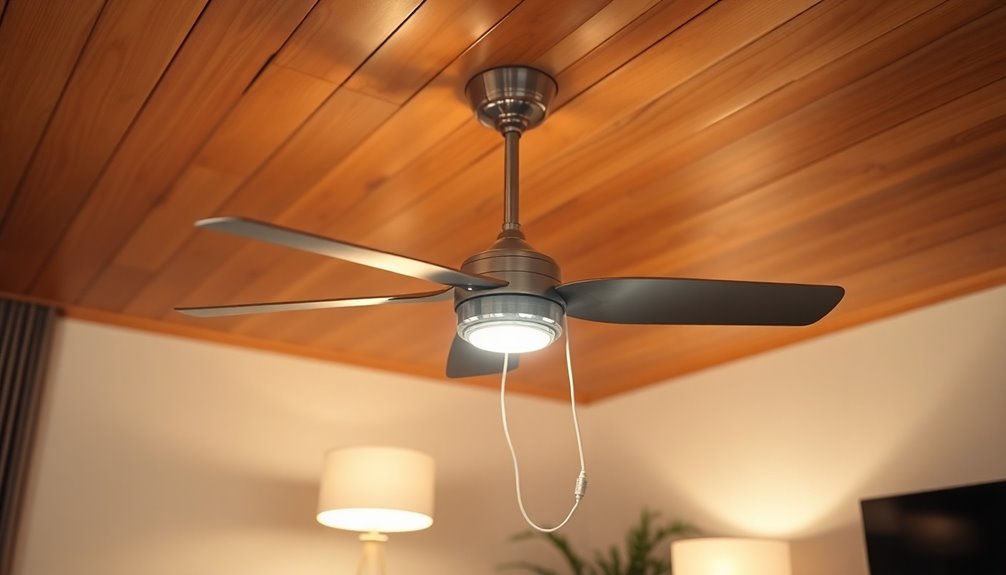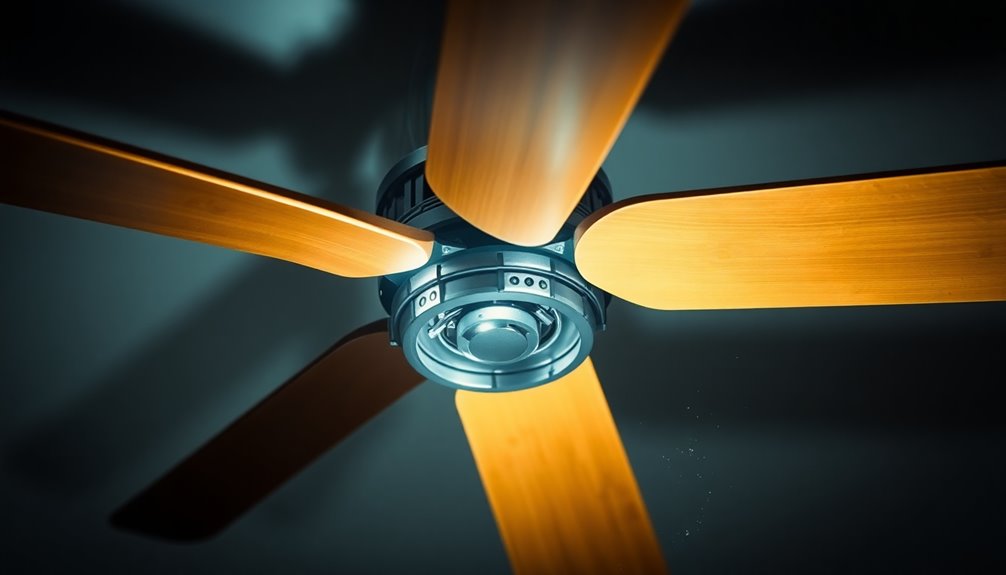Ceiling fans come in a variety of sizes, from 29 inches for small rooms to over 96 inches for extra-large spaces. For rooms up to 75 sq ft, a fan with a blade span of 29 to 36 inches works best. Medium rooms, between 75 to 175 sq ft, benefit from a 42 to 48-inch fan. If you're dealing with larger areas of 175 to 350 sq ft, consider fans that are 52 to 56 inches. It's important to measure your space accurately to find the right fit, and there's more to discover about optimizing your choice!
Key Takeaways
- Ceiling fan blade spans range from 29 inches to 96 inches, catering to various room sizes and applications.
- Small rooms (up to 75 sq ft) require fans with 29 to 36-inch blades for effective airflow.
- Medium rooms (75 to 175 sq ft) are best suited for fans with 42 to 48-inch blades.
- Large rooms (175 to 350 sq ft) benefit from fans with 52 to 56-inch blades for optimal air circulation.
- Extra-large spaces over 350 sq ft need fans with 60 inches or wider blade spans for ideal comfort.
Popular Ceiling Fan Sizes

When choosing a ceiling fan, it's vital to evaluate the size that best fits your space. Ceiling fan sizes vary markedly, with blade spans ranging from 29 inches to 96 inches.
For small rooms up to 75 square feet, fans with a blade span of 29 to 36 inches are ideal. These sizes guarantee optimal airflow without taking up too much space.
In medium rooms, which range from 75 to 175 square feet, a fan diameter of 42 to 48 inches works well. This size provides effective air circulation while maintaining a balanced look.
For large rooms between 175 and 350 square feet, you should consider fans sized from 52 to 56 inches. This size range guarantees proper air movement and keeps the area comfortable.
If you've got an extra-large space of over 350 square feet, you'll need a ceiling fan that's 60 inches or wider. This size is essential for substantial air movement and cooling efficiency.
Selecting the right ceiling fan size based on your room dimensions is key to enjoying the benefits of improved air circulation.
Choosing the Right Fan Size

When you're picking the right ceiling fan, room size plays a significant role.
For small rooms, you'll want fans with a 29 to 36-inch blade span, while larger spaces require fans that are 52 inches or wider.
Don't forget to account for your ceiling height, as this can impact airflow and fan effectiveness.
Room Size Considerations
Selecting the right ceiling fan size is vital for guaranteeing effective air circulation in your space. The size of your room plays an important role in determining which fan will work best for you. Here's a quick reference guide to help you choose the right blade span for your specific room size:
| Room Size | Recommended Fan Size |
|---|---|
| Small Rooms | 29 to 36 inches |
| Medium Rooms | 36 to 48 inches |
| Large Rooms | 52 to 56 inches |
| Extra-Large Spaces | 60 inches or wider |
For small rooms up to 75 sq. ft., a fan with a diameter of 29 to 36 inches will provide adequate airflow efficiency. In medium rooms, which range from 75 to 175 sq. ft., look for fans measuring 36 to 48 inches. Large rooms between 175 to 350 sq. ft. need fans with a blade span of 52 to 56 inches. Finally, for extra-large spaces over 350 sq. ft., choose fans that are 60 inches or wider. Always consider room dimensions and ceiling height for maximum comfort.
#
Blade Span Recommendations
Choosing the right blade span for your ceiling fan directly influences air circulation and comfort in your space.
Selecting the appropriate fan size guarantees that each room benefits from ideal airflow. Here are some recommendations based on room size:
- Small Rooms: For spaces up to 75 sq ft, like bathrooms or breakfast nooks, opt for fans with a blade span of 29 to 36 inches. This size effectively circulates air without overwhelming the space.
- Medium-Sized Rooms: In areas such as bedrooms and kitchens (up to 144 sq ft), a fan with a blade span of 42 to 48 inches is ideal. This provides adequate airflow for comfort while maintaining a balanced aesthetic.
- Large Ceiling Fans: For living rooms or media rooms up to 225 sq ft, choose fans with a blade span of 52 to 56 inches. This size guarantees efficient air movement, enhancing your overall comfort.
- Extra-Large Spaces: For great rooms exceeding 350 sq ft, consider fans with a blade span of 60 inches or more. This ensures ideal comfort in expansive areas, making your environment welcoming and enjoyable.
Measuring Room Dimensions

Accurate room measurements are essential for finding the right ceiling fan size. Start by measuring the length and width of your room in feet. Multiply these dimensions together to calculate the total square footage. This measurement helps you determine the appropriate ceiling fan size needed for effective air circulation.
For small rooms up to 75 square feet, look for fans with a diameter between 29 to 36 inches.
If your room falls into the medium category, ranging from 75 to 175 square feet, you'll want a ceiling fan with a blade span of 36 to 42 inches for ideal airflow.
In large rooms measuring between 175 to 350 square feet, fans that are 52 to 56 inches in diameter are perfect.
If you're dealing with an extra-large space over 350 square feet, consider ceiling fans with a diameter of 60 inches or more to guarantee efficient air circulation.
Ceiling Fan Height Considerations

When it comes to ceiling fan installation, height matters considerably for both safety and performance.
You'll want to verify your ceiling fan height from floor is appropriate to maximize airflow and prevent accidents. Ideally, fan blades should be positioned about 8-9 feet from the floor.
Here are key considerations for fan mounting:
- Minimum Clearance: Hang your fan at least 7 feet above the floor for safety.
- Downrod Length: For standard ceilings of 8-9 feet, a downrod may be necessary to achieve the suitable fan height.
- Distance from Walls: Maintain at least 12 inches from the walls to promote effective air circulation.
- Low vs. High Ceilings: For low ceilings, you might need a flush-mount fan, while high ceilings may require a longer downrod for peak performance.
Additionally, selecting the right fan size will enhance energy efficiency and improve comfort in your living space.
## Blade Span Recommendations

Finding the right ceiling fan size is just as important as confirming it's hung at the proper height. When it comes to blade span, you want to choose a fan that matches your room dimensions for maximum air movement.
For rooms up to 75 square feet, a fan with a blade span of 29 to 36 inches is ideal for effective air circulation.
In medium-sized rooms, which range from 75 to 175 square feet, fan size recommendations suggest using blades that span 42 to 48 inches. This size guarantees you achieve sufficient airflow without overwhelming the space.
For larger rooms, from 175 to 350 square feet, opt for fans with a blade span of 52 to 56 inches. This will help maintain adequate air movement throughout the area.
Finally, if you're dealing with extra-large spaces over 350 square feet, look for fans with a blade span of 60 inches or more. These larger fan blades are essential for achieving sufficient air circulation in expansive environments.
Airflow and Efficiency Factors

When choosing a ceiling fan, understanding airflow measurement standards is essential for maximizing comfort.
You'll want to pay attention to fan efficiency ratings, as they indicate how well a fan circulates air relative to energy consumption.
Airflow Measurement Standards
Ceiling fans consistently play an essential role in enhancing indoor comfort by effectively moving air, and their performance is measured in CFM (cubic feet per minute). Understanding airflow measurement standards can help you choose the right fan for your space. Higher CFM ratings generally indicate better air circulation and comfort.
To optimize airflow and efficiency, consider the following factors:
- Fan Size: Match the fan size with your room dimensions; for small rooms, fans should be 29-36 inches wide, while great rooms need fans 60 inches or wider.
- Blade Height: Confirm the fan's blades are at least 8 feet from the floor for safe and effective air circulation, especially in larger spaces.
- Blade Pitch: A higher blade pitch can greatly enhance airflow efficiency, allowing for better air movement at lower speeds.
- Energy Efficiency: Look for energy-efficient ceiling fans, often rated by CFM, to reduce energy consumption while maintaining comfort for both heating and cooling needs.
Fan Efficiency Ratings
Choosing a ceiling fan involves more than just considering size and airflow; efficiency ratings play a significant role in performance and energy consumption. When selecting a fan, you'll want to look at its CFM (cubic feet per minute) rating, as higher CFM ratings indicate better air movement capacity and airflow efficiency.
Energy-efficient models, especially those with an Energy Star rating, can use up to 20% less energy than standard fans, helping you save on electricity costs. The blade pitch also impacts airflow; fans with a higher blade pitch can enhance air circulation while operating at lower speeds, making them more efficient.
Additionally, fans equipped with DC motors are generally more energy-efficient than those with AC motors. They consume less energy and operate more quietly, enhancing your overall comfort. Furthermore, selecting fans from the best air flow ceiling fans category can significantly improve your home's cooling efficiency.
To achieve peak performance, it's crucial to choose properly sized fans for your room dimensions. This guarantees effective cooling or heating while minimizing energy usage.
Optimal CFM Requirements
Understanding ideal CFM requirements is essential for achieving the best airflow and efficiency in your space. Ceiling fan airflow efficiency is measured in CFM (Cubic Feet per Minute), where higher CFM ratings indicate better air movement.
To guarantee you select the proper fan size for your room, take into account the following guidelines:
- Small Rooms (50-75 sq ft): Look for fans with a CFM range of 1,000-2,000 for adequate cooling.
- Standard Rooms (75-175 sq ft): Aim for fans that provide up to 3,800 CFM for peak air circulation.
- Large Rooms (175-350 sq ft): Choose fans with CFM nearing 8,000 to guarantee effective airflow.
- Great Rooms (≥350 sq ft): Select fans with CFM ratings between 8,000-16,900 or more for maximum efficiency.
Using fans with longer blade spans usually produces more airflow at lower speeds, enhancing energy savings.
Properly sized fans help maintain comfortable temperatures and allow you to set higher thermostat levels in conjunction with heating and cooling systems.
Make sure to take into account these factors to maximize your ceiling fan's performance.
Outdoor Ceiling Fan Options

When it comes to outdoor ceiling fan options, selecting the right size and rating is essential for both comfort and durability. You'll typically find outdoor ceiling fans ranging from 52 inches to 60 inches in blade span, making them perfect for medium to large patios and outdoor spaces. A 60-inch fan is especially effective for air circulation, ensuring you stay cool in expansive areas.
When choosing your fan, consider the rating: damp-rated fans can handle humidity and light moisture, while wet-rated fans are designed for direct exposure to rain. Here's a quick comparison to help you decide:
| Fan Size | Ideal For | Rating Type |
|---|---|---|
| 52 inches | Medium Patios | Damp-rated |
| 60 inches | Large Outdoor Spaces | Wet-rated |
| Popular Models | Bureau, Crestfield, Warrant | Various Ratings |
Installation and Maintenance Tips

For a successful ceiling fan installation, it's vital to verify the electrical box is rated for fan support.
Using a metal box is important for safety during the installation process.
Follow these tips to guarantee your fan operates efficiently and safely:
- Read the Manual: Carefully follow the instruction manual for proper assembly and safety precautions during installation.
- Maintain Clearance: Confirm there's a minimum clearance of 7 feet from the floor to the fan blades for ideal airflow and safety.
- Check Electrical Connections: If you're unsure about the electrical connections, consider hiring a qualified electrician to make sure everything's set up correctly.
- Regular Maintenance: Make it a habit to regularly clean the fan blades and motor to prevent dust buildup, which can diminish performance and shorten the fan's lifespan.
Frequently Asked Questions
What Are Standard Sizes for Ceiling Fans?
When you're choosing a ceiling fan, consider the room size to determine the standard size you'll need.
For small rooms, 29 to 36 inches works best, while medium spaces benefit from fans between 42 and 48 inches.
If you're dealing with large rooms, look for fans around 52 to 56 inches.
For extra-large areas, you'll want a fan that's at least 60 inches.
Finding the right size guarantees efficient airflow and comfort in your space.
Is a 52 Inch Fan Too Big for a 12X12 Room?
Have you ever felt like you were caught in a wind tunnel? A 52-inch fan can indeed be too big for a 12×12 room, creating excessive airflow and discomfort.
Ideally, you'd want a fan between 36 and 44 inches for such a space. If you choose the larger fan, consider running it on a lower speed to keep the air circulation pleasant without overwhelming the room.
Your comfort's key!
What Size Ceiling Fan for a 20X20 Room?
For a 20×20 room, you'll want a ceiling fan with a blade span of 52 to 60 inches.
This size will guarantee ideal airflow and keep the space comfortable.
If your ceiling is higher than 9 feet, consider a longer downrod to maintain effective airflow.
Aim for a fan with a high CFM rating—around 5,000 or more—to enhance cooling efficiency.
Proper placement and sizing will make your room feel more inviting.
Are 3 or 5 Blade Ceiling Fans Better?
You might think that more blades always mean better airflow, but that's not necessarily true.
When choosing between 3 or 5 blade ceiling fans, consider your space's needs. A 5-blade fan often circulates air more effectively, but a well-designed 3-blade fan can be just as efficient and quieter.
Evaluate your room size and design preferences to find the perfect balance—it's not just about how many blades there are, but how they perform in your home.
Conclusion
When choosing a ceiling fan, size really does matter. Did you know that a properly sized ceiling fan can improve airflow by up to 50%? Whether you opt for a compact fan for a small room or a larger model for an open space, getting the right fit guarantees comfort and efficiency. Remember to take into account your room's dimensions and ceiling height for the best results. With the right fan, you'll enjoy a cooler, more inviting atmosphere all year round!








